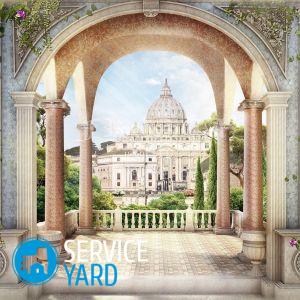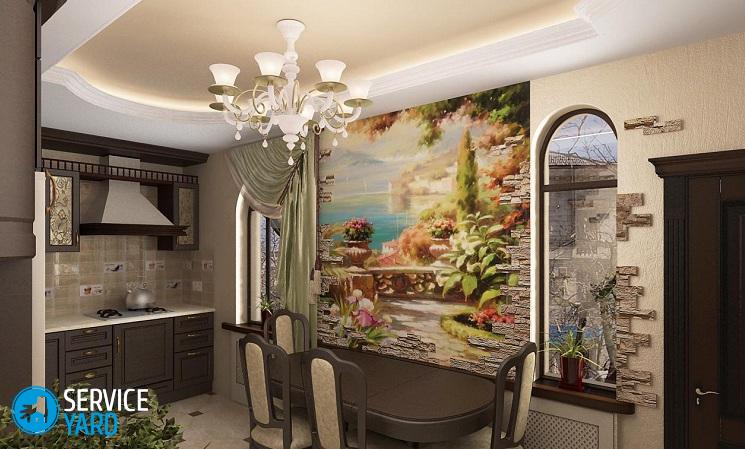Fresco on the wall

Often, upon completion of repairs, unformed empty walls remain, which can be decorated with a fresco on the wall. This finish option was used in ancient times. Nowadays, their use is gaining more and more popularity. A fresco is a decorative decoration of walls made on raw plaster. In ancient times, painting a mural on the surface was a long and exhausting work, but in our time this process does not take so much time. To decorate the wall with a fresco, there are a huge number of technologies for applying them to the wall and other surfaces. What are the types of frescoes, their advantages and do-it-yourself manufacturing, we will consider below.
to contents ↑Types of frescoes
To give their home a unique and exclusive look, many use murals on the wall in the interior. They can be either selected from a huge assortment, or made to order or with your own hands.
There are such types:
- Classic.
- On the canvas.
- Non-woven.
- Self adhesive.
- With flexible plaster.
- On a tight basis.
Consider all types in more detail.
Classic
This is a wall painting in the interior, which is applied to the freshly putty. A qualified specialist draws up an image. This is a very time-consuming process that takes place throughout the day. The main condition - there should be no corrections when applying the picture.
Important! This is the most expensive procedure, which is used very rarely, mainly in classic exclusive interiors.
On the canvas
The fresco on the wall on the canvas is made by hand. The technology is very complex, they are painted with natural pigments instead of paints, and then the canvas is artificially aged. Cover the mural with a protective layer of wax.
Important! Such products will require constant care.
Non-woven
Often used for large areas of frescoes on the wall in the interior based on non-woven. Thanks to modern technologies and sophisticated production techniques, they are very similar to classic ones. To extend the life of the surface, the murals are treated with a special varnish. You can attach it to the wall with glue for non-woven wallpaper. It fits perfectly into any interior, as there is a wide variety of designs.
Self adhesive
This look is very similar to photo wallpaper or textured wallpaper. A layer of fine river sand is applied to a self-adhesive base and imitates plaster. This type is glued easily, but does not hide the roughness of the walls, because it is very thin. The advantage is the ability to apply any image that is printed by a computer.
With flexible plaster
This is the most popular fresco today. The manufacturing technology and beauty is very similar to the classic. The use of modern plaster, which dries much longer, allows the master to extend the time to complete the work.
Important! Dyes on a natural basis help to achieve similarity with a real mural.
On a tight basis
In the manufacture of this type, plastic, ceramic or wooden substrates are most often used. They allow the specialist to simulate chips, make cracks and easily achieve an aging effect.
to contents ↑Important! The weight of such a mural is large, so they are made small in size.
The advantages of fresco decor:
- A huge selection of drawings and a variety of designs make it possible to choose wall decoration in any style.
- With it, you can expand the visual space.
- Creates a romantic and cozy atmosphere in an apartment or house.
- Safe - only natural dyes are used in the manufacture.
- Moisture-resistant, as well as resistant to sunlight.
Recommendations before starting production:
- Consider the general style of the room when choosing a pattern.
- The fresco on the wall in the bedroom should be peaceful and harmonious. Images of sea landscapes, flowers or high-quality photos from your travels are perfect for this room.
- Use a cartoon style when decorating a nursery.
- For the living room, use images in a modern or classic style. The main thing is to keep harmony.
- For the bathroom and kitchen, the main criterion will be moisture resistance and practicality.
Fresco making
Having some artistic skills, you can create this type of decor with your own hands. To do this, you will need patience and quality materials.
Necessary materials:
- Water-based acrylic paints.
- Brushes.
- Stylus.
- Sketch.
- Varnish or wax.
Manufacturing process:
- Prepare the walls - for this they need to be leveled and a layer of plaster applied.
- Apply a coat of primer on top and wait until the walls are completely dry.
- Transfer the sketch from the sketch to the wall using a stylus. Draw the back side of the sketch with a stylus, attach it with this side to the surface, after - circle along the contours so that your drawing is designed on the wall.
- Paint the sketch.
- Cover with a wax or varnish.
Mural wallpaper
Mural wallpaper in the interior is an alternative to photo wallpaper. They make fresco wallpapers from paintings on non-woven or fiberglass material.
Main advantages:
- Durability and the possibility of applying any image with the desired texture in a short period of time.
- You can make any size of such wallpapers.
- Suitable for any style.
Important! Carefully monitor the joints when pasting such wall paintings, because even a small roughness will ruin the picture.
- After the wall sticker, the murals are varnished to protect against moisture.
- Stick on any surface.
to contents ↑Important! When gluing and drying the wallpaper should not be drafts.
Stock footage
The use of frescoes on the wall in the interior is very important in our time. They help express the general mood of housing, make it modern and original. It is not difficult to make such a decor with your own hands, and the result will please you for many years, creating a special cosiness and atmosphere in your home.
- How to choose a vacuum cleaner taking into account the characteristics of the house and coatings?
- What to look for when choosing a water delivery
- How to quickly create comfort at home - tips for housewives
- How to choose the perfect TV - useful tips
- What to look for when choosing blinds
- What should be running shoes?
- What useful things can you buy in a hardware store
- Iphone 11 pro max review
- Than iPhone is better than Android smartphones




